Wave Breaker |
|||||||||||||||||||||||||
 |
 |
||||||||||||||||||||||||
Crocheted sweater in DROPS Flora and DROPS Kid-Silk. The piece is worked bottom up with lace pattern. Sizes S - XXXL
DROPS 240-2 |
|||||||||||||||||||||||||
|
------------------------------------------------------- EXPLANATIONS FOR THE PATTERN: ------------------------------------------------------- CHAIN STITCH: If you work outermost on the hook the chain stitch will often be too tight; 1 chain stitch should be as long as 1 single/double crochet is wide. CROCHET INFORMATION: At the beginning of each row of double crochets work 3 chain stitches, which replace the first double crochet. The last double crochet on the row is worked in the 3rd chain stitch from the beginning of the row. When working in the round (sleeves and neck): At the beginning of each round of double crochets work 3 chain stitches, which replace the first double crochet. The round finishes with 1 slip stitch in the 3rd chain stitch. At the beginning of each round of single crochets work 1 chain stitch, which replaces the first single crochet. The round finishes with 1 slip stitch in the first chain stitch at the beginning of the round. DECREASE TIP: Decrease 1 stitch by working 2 double crochets together as follows: * Make 1 yarn over, insert the hook through the next double crochet, pick up the strand, make 1 yarn over and pull it through the first 2 loops on the hook *, work from *-* 1 more time, make 1 yarn over and pull it through all 3 loops on the hook (= 1 double crochet decreased). PATTERN: See diagrams A.1 to A.4. ------------------------------------------------------- START THE PIECE HERE: ------------------------------------------------------- SWEATER – SHORT OVERVIEW OF THE PIECE: The front and back pieces are worked separately, back and forth. The sleeves are worked in the round, turning after each round, working alternately from the right and wrong side. This gives you the same texture as on the body. The neck is worked to finish. BACK PIECE: Work 67-75-79-87-95-103 chain stitches – read CHAIN STITCH, with hook size 5 MM = US H/8 and 1 strand of each quality (2 strands). Work 1 double crochet in the 4th chain stitch from the hook then 1 double crochet in each of the remaining chain stitches = 65-73-77-85-93-101 stitches. Read CROCHET INFORMATION! Work 3 chain stitches (first double crochet), work A.1 to the end of the row. Repeat the last 2 rows in A.1 until the piece measures 6 cm = 2⅜" – with the last row being a row of single crochets from the wrong side, then work a row of double crochets (1 double crochet in each stitch). Continue with pattern as follows: Work A.2C, then A.2B until there are 5 double crochets left, A.2A. Continue back and forth; A.2 is repeated in height. REMEMBER THE CROCHET GAUGE! SIZES M- L- XL- XXL-XXL: When the piece measures 37-38-39-40-41 cm = 14½"-15"-15¼"-15¾"-16⅛" (with the next row a row similar to row 2 in the diagram), bind off for the armholes as follows (armholes are not worked in size S): Work 1 slip stitch in each of the first 4-4-8-8-12 stitches, work double crochets as before over the next 65-69-69-77-77 stitches (4-4-8-8-12 double crochets left on the row). ALL SIZES: Work pattern as before back and forth over the 65-65-69-69-77-77 stitches until the piece measures 52-54-56-58-60-62 cm = 20½"-21¼"-22"-22¾"-23⅝"-24⅜", then continue with double crochets (with at least 2 rows of double crochets after the lace pattern before working the neck). Continue working until the piece measures 54-56-58-60-62-64 cm = 21¼"-22"-22¾"-23⅝"-24⅜"-25¼" – with the next row from the right side. Work the first 19-19-19-19-23-23 double crochets on the right shoulder, work the next 2 double crochets together – read DECREASE TIP, turn, work back over the 20-20-20-20-24-24 stitches. The piece measures 56-58-60-62-64-66 cm = 22"-22¾"-23⅝"-24⅜"-25¼"-26". Cut and fasten the strands. Skip the middle 23-23-27-27-27-27 stitches, start in the 24th-24th-28th-28th-28th-28th stitch and work the last 21-21-21-21-25-25 double crochets on the left shoulder, starting from the right side and neck as follows: Work the first 2 double crochets together, work 1 double crochet in each of the remaining 19-19-19-19-23-23 double crochets. Turn and work 1 double crochet in each of the 20-20-20-20-24-24 double crochets. Cut and fasten the strand. SIZE S: Insert 1 marker-thread in each side, 20 cm = 8" down from the shoulder to mark the armholes. FRONT PIECE: Work in the same way as the back piece until the front measures 49-51-52-54-55-57 cm = 19¼"-20"-20½"-21¼"-21⅝"-22½". Now work the neck, with at least 2 rows of double crochets after the finished lace pattern and continuing with double crochets. RIGHT AND LEFT SHOULDER: Work the first 22-22-22-22-26-26 double crochets, 2 double crochets together (1 double crochet decreased), turn and work 2 double crochets together (1 double crochet decreased), work to the end of the row. Work the first 20-20-20-24-24-24 stitches, 2 double crochets together (1 double crochet decreased), turn and work 2 double crochets together (1 double crochet decreased), work to the end of the row = 20-20-20-20-24-24 double crochets on the shoulder. Continue back and forth until the piece measures 56-58-60-62-64-66 cm = 22"-22¾"-23⅝"-24⅜"-25¼"-26" from the shoulder down – finishing after a row from the right side. Cut and fasten the strands. Skip the next 17-17-21-21-21-21 double crochets (neck), start in the 18th-18th-22nd-22nd-22nd-22nd double crochet from the right side and work as follows: Work 2 double crochets together (1 double crochet decreased), work to the end of the row. Turn and work the first 21-21-21-21-25-25 stitches, work 2 double crochets together (1 double crochet decreased). Work 2 double crochets together (1 double crochet decreased), work to the end of the row. Turn and work the first 19-19-19-19-23-23 double crochets, work 2 double crochets together (1 double crochet decreased) = 20-20-20-20-24-24 double crochets on the shoulder. Continue back and forth until the piece measures 56-58-60-62-64-66 cm = 22"-22¾"-23⅝"-24⅜"-25¼"-26" from the shoulder down – finishing after a row from the right side. Cut and fasten the strands. SIZE S: Insert 1 marker-thread in each side, 20 cm = 8" down from the shoulder to mark the armholes. SLEEVES: Work 45-45-45-49-49-49 chain stitches – remember CHAIN STITCH, with hook size 5 MM = US H/8 and 1 strand of each quality (2 strands). Form them into a ring with 1 slip stitch in the first chain stitch. Work 1 double crochet in each chain stitch = 45-45-45-49-49-49 stitches. Work 3 chain stitches (first double crochet), work A.3 to the end of the round. Repeat round 1 onwards until the sleeve measures 8 cm = 3⅛". Work round 2 in A.3. Then continue as follows: Work A.4A, repeat A.4B and finish with 1 slip stitch at the beginning of the round. You are working in the round (but now turning after each round) and A.4 is repeated in height. Make sure the rounds of treble crochets and chain stitches are worked from the right side so the texture is the same as on the body. When the sleeve measures 13 cm = 5⅛" (making sure you increase on a round of double crochets), start to increase under the sleeve. Increase 1 double crochet in the first and last double crochet on the round by working 2 double crochets in the stitches. Increase like this every 8-6-5-4½-3½-3 cm = 3⅛"-2⅜"-2"-1⅝"-1¼"-1⅛" a total of 5-7-8-8-9-10 times (always on a round of double crochets) = 55-59-61-65-67-69 stitches. The stitches which do not fit into A.4 are worked with double crochets. Continue working until the sleeve measures 53-51-50-48-46-44 cm = 21"-20"-19¾"-19"-18"-17¼". The sleeve is finished in size S. Work 1 more sleeve like this in size S. SIZES M- L-XL-XXL-XXXL: Now work back and forth, starting from the beginning of the round, to leave a split under the sleeve. When the sleeve measures 54-53-54-52-53 cm = 21¼"-21"-21¼"-20½"-21" it is finished. Cut and fasten the strands. Work the other sleeve in the same way. ASSEMBLY: Sew the shoulder seams. Sew the sleeves to the armholes as shown in the sketch. Sew the side seams down from the armholes. NECK: Start at the top of one shoulder, with hook size 5 MM = US H/8 and 1 strand of each quality (2 strands): Fasten with 1 single crochet in the shoulder seam, * work 2 chain stitches, skip 1 cm = ⅜", work 1 single crochet *, work from *-* a total of 24-24-26-26-26-26 times on the round, finishing with 1 slip stitch in the first single crochet. Work 3 chain stitches – remember CROCHET INFORMATION, then 3 double crochets around each chain-space = 72-72-78-78-78-78 double crochets and + 3 chain stitches to turn. Continue in the round with A.3. Repeat round 1 in A.3 until the neck measures 5 cm = 2" (including the first round of double crochets). Cut and fasten the strands. |
|||||||||||||||||||||||||
Diagram explanations |
|||||||||||||||||||||||||
|
|||||||||||||||||||||||||

|
|||||||||||||||||||||||||

|
|||||||||||||||||||||||||

|
|||||||||||||||||||||||||

|
|||||||||||||||||||||||||
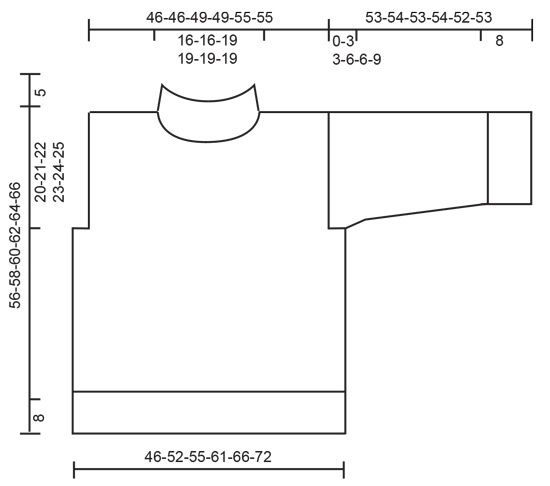
|
|||||||||||||||||||||||||
|
Have you made this or any other of our designs? Tag your pictures in social media with #dropsdesign so we can see them! Do you need help with this pattern?You'll find tutorial videos, a Comments/Questions area and more by visiting the pattern on garnstudio.com. © 1982-2024 DROPS Design A/S. We reserve all rights. This document, including all its sub-sections, has copyrights. Read more about what you can do with our patterns at the bottom of each pattern on our site. |
|||||||||||||||||||||||||








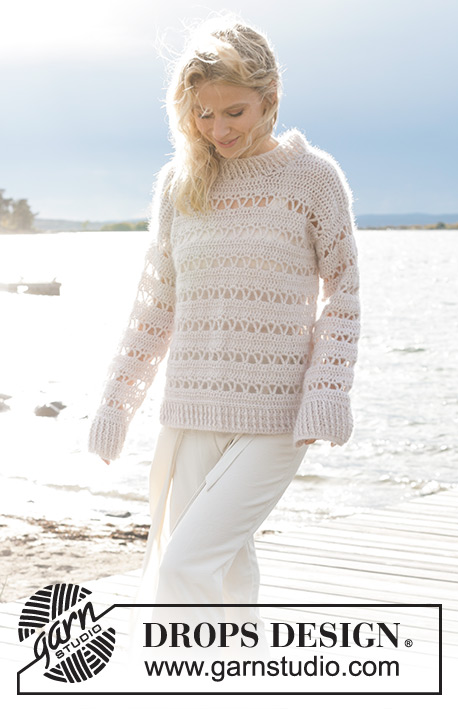




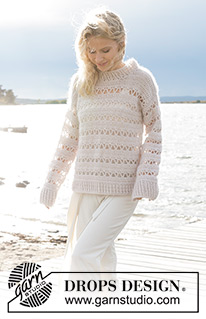




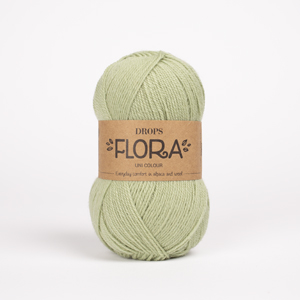
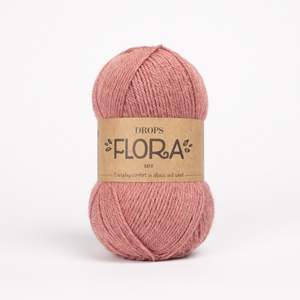










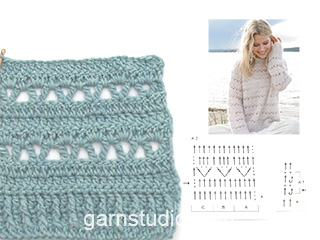
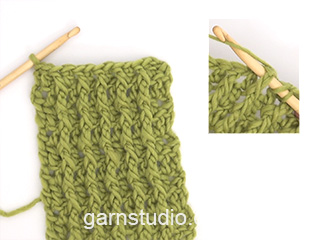

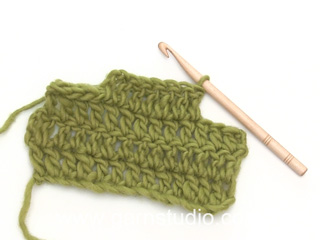


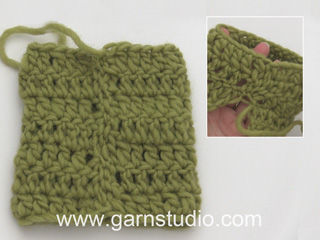
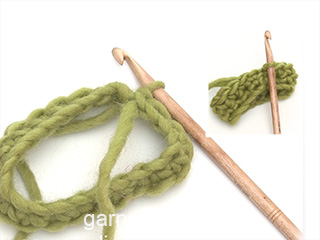



















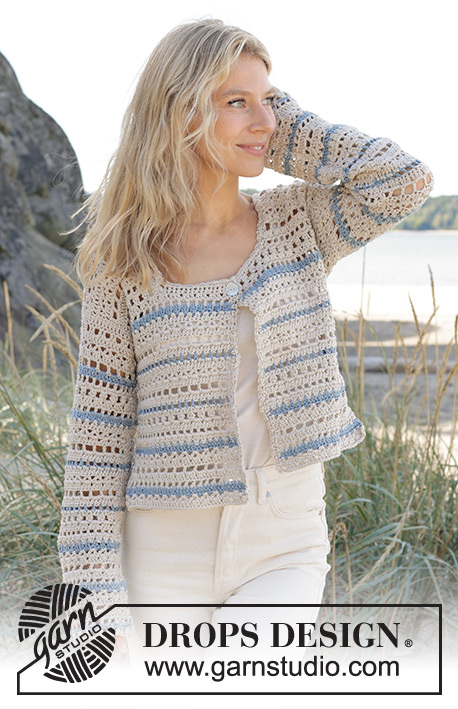







Comments / Questions (17)
Boa tarde . Adoro os vossos modelos , parabens pelo site. Comprei drops flora + drops kid silk para fazer este modelo, mas nao gosto do toque do fio drops kid silk, tem muitos pelos e nao era o eu pretendia. Pois na foto nao se vêem tantos pelos. Gostaria de saber que fio me aconselham para subtituir o kid silk? Ou se posso fazer so com drops flora e que agulha recomenda ? Muito obrigada . Cumprimentos
15.09.2023 - 16:02DROPS Design answered:
Bom dia, Muito obrigado pelo seu comentário. Trabalhamos muito para poder trazer novos modelos gratuitos. Pode, em alternativa, dobrar o Flora (=usar 2 fios) ou combinar o Flora com o Alpaca (que tem muit menos pêlo do que o Kid.Silk). Bons crochés!
19.09.2023 - 10:19Bonjour Pour la mamche ; vois mentionnez de ceocheter en rond mais de tourner à chaque tour? Autrement dit nous fesons jn rang à l’endroit et un rang sur l’envers toujours en continue au lieu d’être toujours sur l’endroit ???? Merci
04.04.2023 - 18:28DROPS Design answered:
Bonjour Myrèle, tout à fait, pensez à bien fermer vos rangs par 1 maille coulée dans la 1ère maille du début du tour pour éviter une couture. Bon crochet!
11.04.2023 - 11:17Modèle attaqué ce soir. Les points sont un régal pour les yeux. Il me tarde de le finir pour le porter.
14.02.2023 - 00:51Will there be more crochet patterns available for the SS2023 collection?
08.02.2023 - 13:23Hello, How do I find the measurements for each size, so I can choose the best one for me? It's the first time I try one of your patterns but I can't seem to find this info anywhere on the page. This collection looks so beautiful! Can't wait to start! Thank you very much! Laura
07.02.2023 - 12:26DROPS Design answered:
Dear Laura, thank you very much! Measure a similar garment you have and like the shape and compare these measurements to those in the chart, this will be the best way to find your size for each garment; read even more here. Happy crocheting!
07.02.2023 - 13:22Hallo Drobs Team! Habe mich direkt in den Pulli verliebt! Habe aber festgestellt, dass sich beim Rückenteil in Größe L bei der Angabe zur Abnahme für den Armausschnitt ein rechnerischer Fehler eingeschlichen hat. 77 - 8 = 69 .Aber man sollte dann nach der Abnahme am Anfang der Reihe nur noch 61 M häkeln um den 2. Armausschnitt zu haben. Hoffentlich ist das hier die richtige Adresse um Korrekturanregungen zu tätigen 🤣 Gruß Ana
04.02.2023 - 17:20DROPS Design answered:
Liebe Frau Oliveira, beachten Sie, daß unter GRÖSSE M- L- XL- XXL-XXL: wird dann die Größe L die 2. Größe so werden nur 4 Maschen beidseitig abgenommen, so sind es 77-8= 69 Maschen übrig. Viel Spaß beim häkeln!
06.02.2023 - 11:03I just wanted to say thank you for putting a crochet 🧶 pattern out so soon with the other new patterns. It’s always so exciting to look at and read the new patterns. Can’t wait to get the summer crochet idea’s flowing. Thank you for all the wonderful patterns Garnstudio has provided for years of fabulous enjoyment. 💖💖💖
04.02.2023 - 07:10Veldig fin heklegenser. Super til våren ! Lagt til i favoritter :-)
03.02.2023 - 13:31Summer cloude
21.01.2023 - 22:46White lightness
21.01.2023 - 12:08